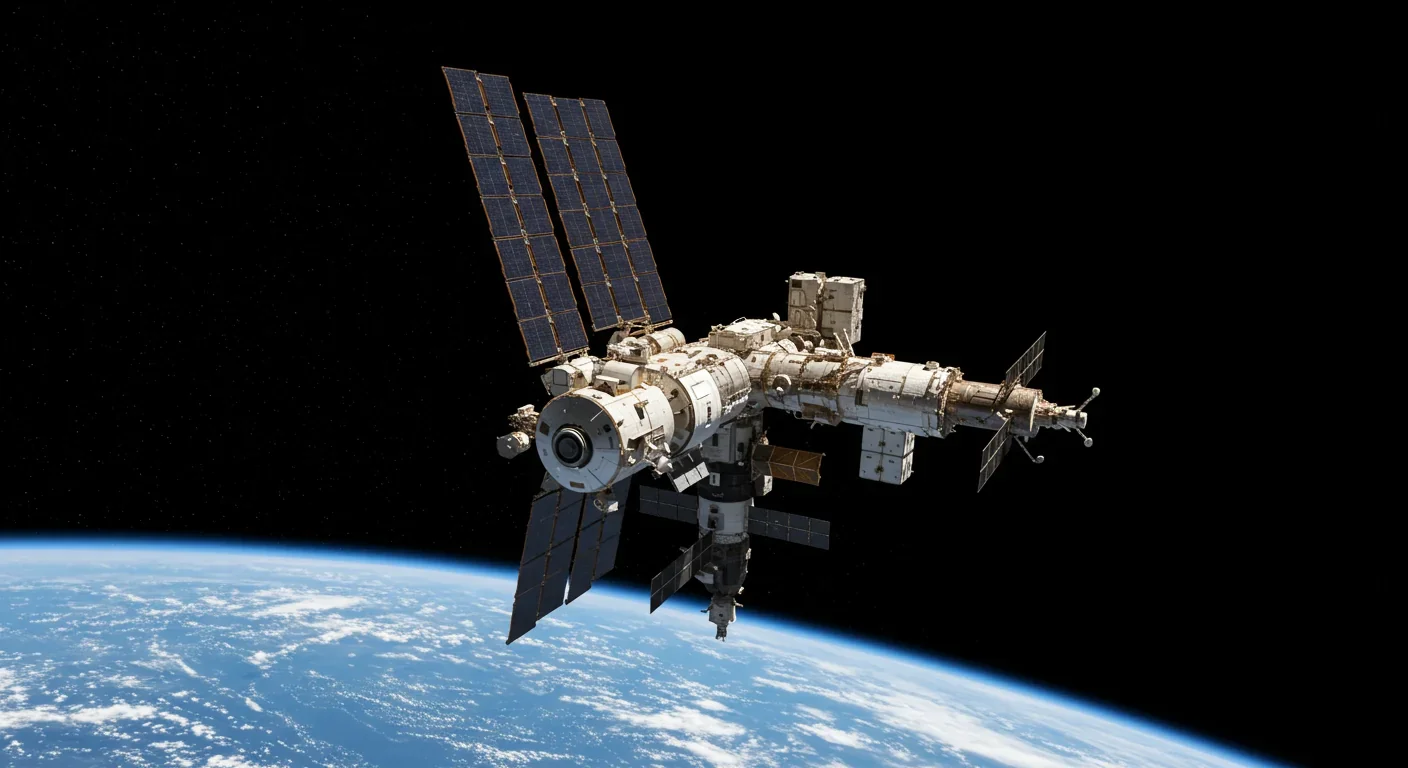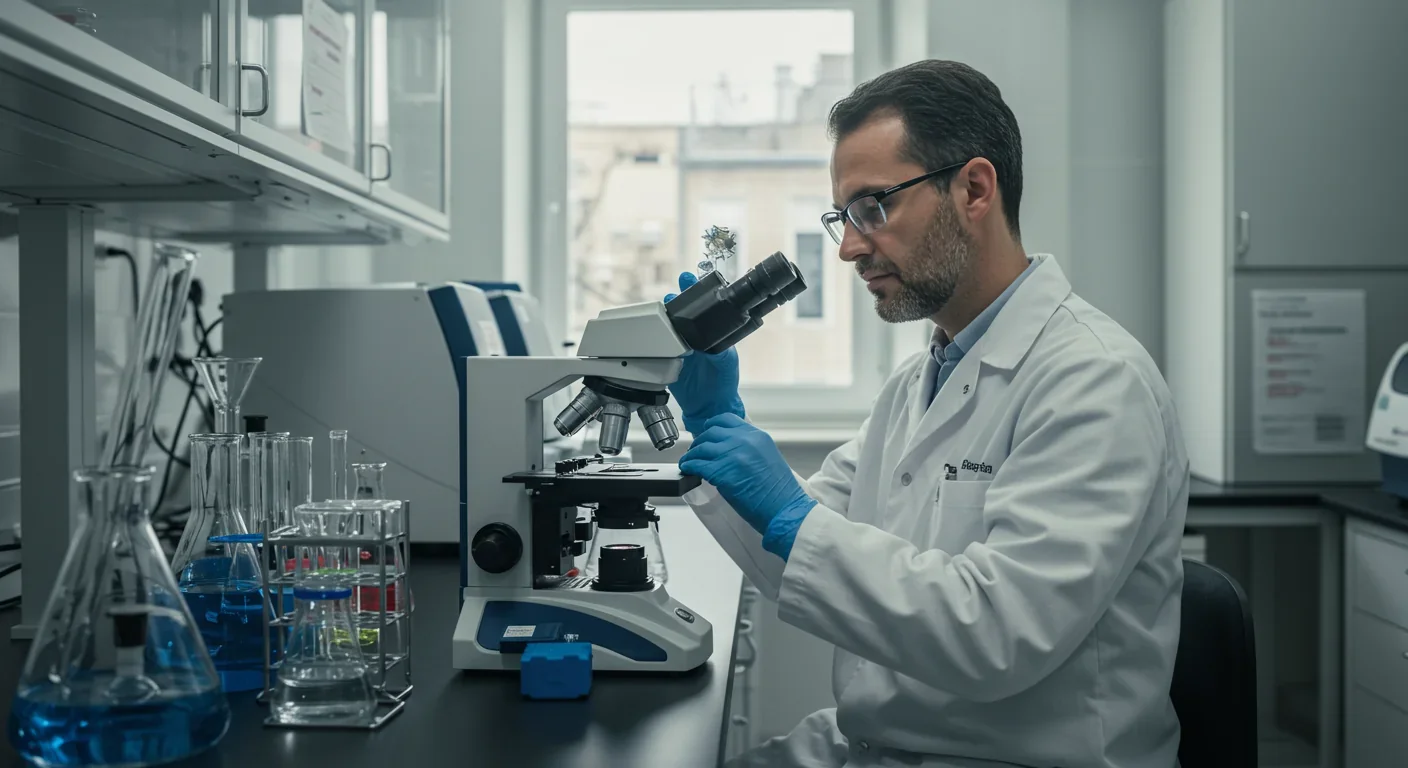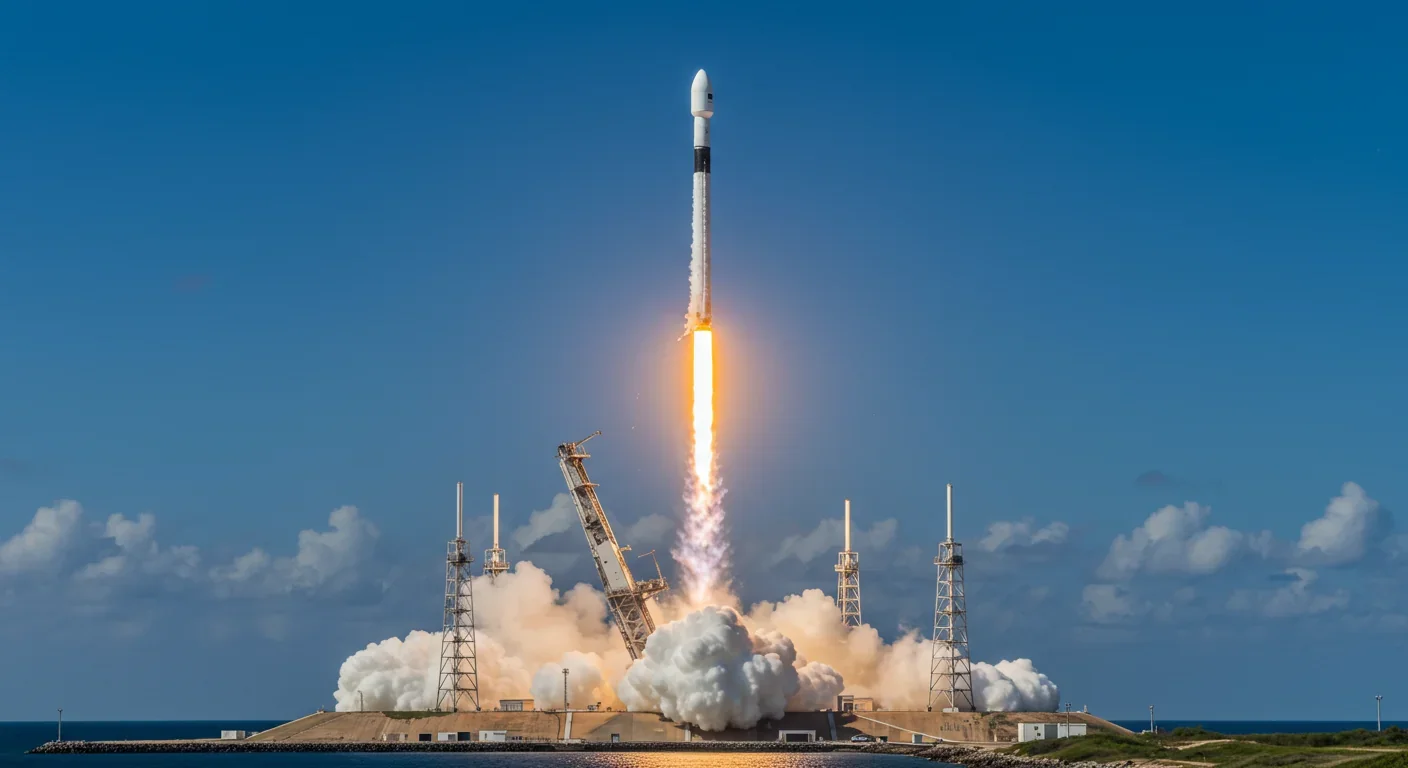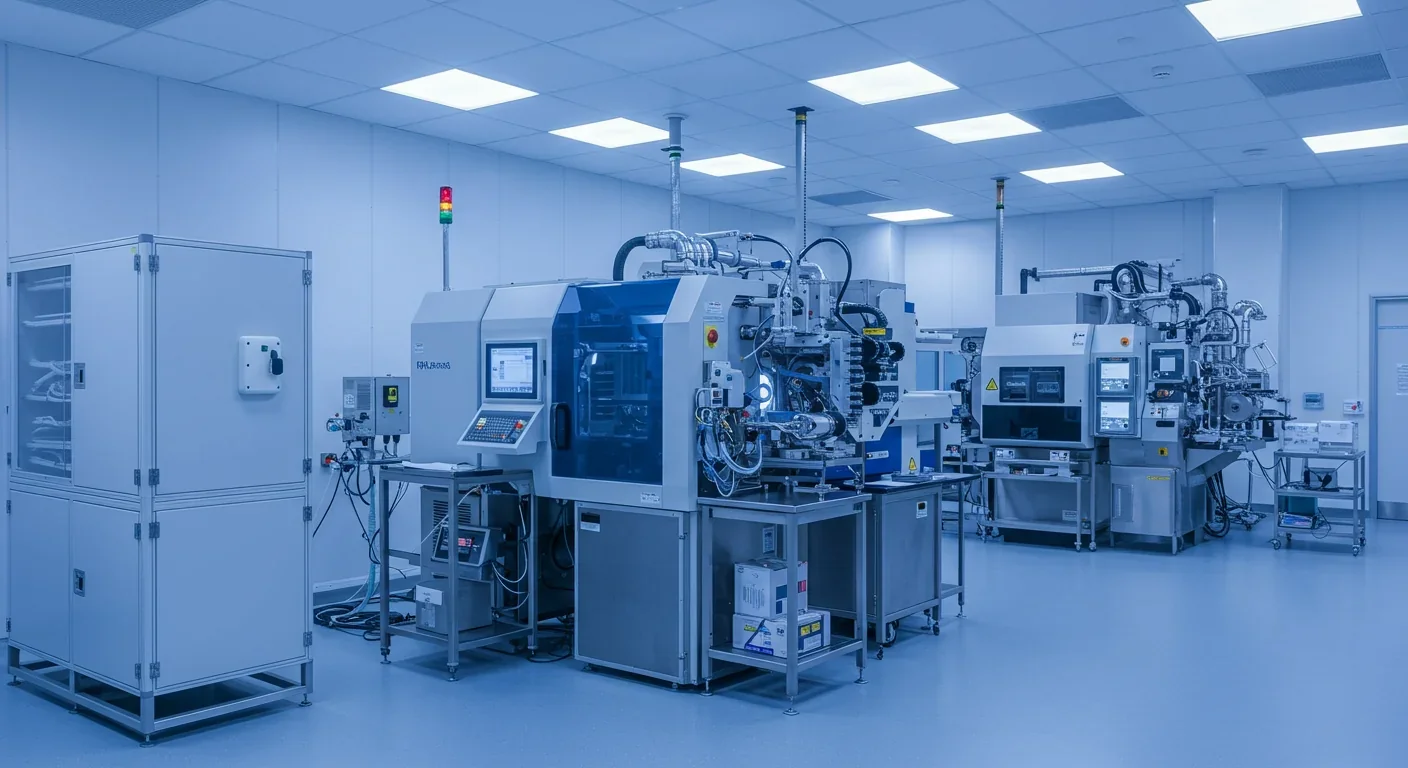Mars Methane Mystery: Hidden Microbes or Geology?

TL;DR: Space manufacturing is transitioning from science experiments to commercial production as companies file patents for zero-gravity processes that produce superior pharmaceuticals, optical fibers, and semiconductors. While the market doesn't exist yet, strategic investments in intellectual property and ISS production scaling suggest orbital manufacturing could become routine for high-value products by 2035.
By 2030, the pharmaceutical you're prescribed might have been crystallized in orbit. The fiber optic cable delivering this article to your screen could one day be manufactured 250 miles above Earth. A quiet revolution is happening aboard the International Space Station, where the absence of gravity is proving to be manufacturing's newest competitive advantage, and companies are rushing to stake their claims in what could become a trillion-dollar industry.

The stakes go far beyond novelty. When Eascra Biotech sent nanomaterials to the ISS on Axiom Mission 2, they returned with samples showing a 40% improvement in structural uniformity compared to Earth-produced versions. That's not incremental progress; it's the kind of leap that creates entirely new product categories. These Janus base nanomaterials, designed to deliver RNA-based drugs more effectively, remained stable at room temperature, eliminating the cold-chain logistics that make distributing many modern medicines prohibitively expensive in developing countries.
Gravity isn't just an inconvenience for manufacturers of advanced materials; it's an active saboteur. On Earth, temperature differences create convection currents in molten substances, causing microscopic defects as crystals form. Heavier particles settle while lighter ones rise, creating inconsistencies. For protein crystals used in drug development or semiconductor crystals for next-generation electronics, these imperfections dramatically reduce performance.
Microgravity eliminates these problems entirely. Without gravity-driven convection, materials self-organize with a precision impossible to achieve in terrestrial facilities. ZBLAN optical fibers, which can theoretically transmit light 100 times more efficiently than silica glass, have been notoriously difficult to produce on Earth because gravity causes crystallization defects. In space, those defects disappear, resulting in fibers with transmission losses that could revolutionize telecommunications, medical imaging, and laser systems.
Without gravity-driven convection, materials self-organize with a precision impossible to achieve in terrestrial facilities, enabling performance improvements that create entirely new product categories.
The University of Toledo's protein crystallography experiments demonstrate this principle in action. By growing larger, more uniform crystals in microgravity, researchers can map protein structures with unprecedented clarity. This matters because understanding a protein's exact three-dimensional structure is essential for designing drugs that bind to specific sites, like creating a key that fits one lock perfectly.

While "space manufacturing" might sound like science fiction, the patent filings and commercial agreements tell a different story. Companies aren't just experimenting; they're building moats around intellectual property that could define industry leadership for decades.
Fiber Optics Manufacturing in Space (FOMS) has secured U.S. patents for its SpaceFORM platform, designed to produce multi-kilometer lengths of ZBLAN fiber in orbit. Their system isn't a small-scale research apparatus but a production facility intended for the ISS, with plans to scale to dedicated manufacturing modules on future commercial stations. FOMS Chief Scientist Dmitry Starodubov describes a future where space-made fiber optics could capture significant market share in telecommunications, where performance gains of even 10% translate to billions in value.
Varda Space Industries has taken a different approach: instead of manufacturing on permanent stations, they've developed reusable spacecraft that spend weeks in orbit producing pharmaceutical crystals before returning to Earth. After three successful missions since 2023 and plans for four more this year, Varda is now building a terrestrial laboratory to systematically identify which biologics benefit most from space processing. Their model acknowledges a crucial reality: for the foreseeable future, the products come back to Earth, even if the manufacturing happens in space.
The semiconductor industry is entering the conversation with serious intent. LatticeX and Zero-G launched Zero-G Materials Inc., specifically targeting ultra-high-quality semiconductor crystal production in microgravity. Sierra Space has signed agreements with Astral Materials and Space Forge for proof-of-concept missions focused on advanced chip technologies. These aren't exploratory research projects; these are partnerships between space infrastructure providers and materials companies betting that microgravity manufacturing will become economically essential.
"In space, we were able to achieve huge gains in uniformity and homogeneity, with up to 40-percent improvement in the structure of the nano-matrix scaffold."
— Mari Anne Snow, CEO of Eascra Biotech

Intellectual property law was written for a world where innovation happened within national borders. Space manufacturing challenges those assumptions in ways that patents and courts are still figuring out. If a company invents a manufacturing process aboard the ISS, which operates under international agreements involving 15 countries, which nation's patent law applies?
The U.S. Space Act attempts to address this by extending U.S. patent jurisdiction to objects and processes created by U.S. entities in space. A patent claim that specifies "a method performed in microgravity" or "a crystal produced in the absence of gravitational convection" can create exclusive rights that effectively control space-based production, even if the underlying chemistry is well understood on Earth.
This creates strategic opportunities and risks. Companies that file patents specifically describing space-based processes could lock competitors out of orbital manufacturing, even if those competitors develop similar technologies independently. Conversely, broad Earth-based patents might not cover space manufacturing if the process differs substantially. Patent attorneys specializing in this emerging field recommend dual-claim strategies: file claims covering both terrestrial and microgravity methods, and include apparatus claims for equipment designed to operate in space.
International tensions add another layer. If China, Russia, or European entities develop similar capabilities, conflicting patent claims could lead to what some experts are calling "orbital patent wars," where manufacturing facilities in different legal jurisdictions produce competing products using processes that may or may not infringe on each other's IP.
The ISS has become an unexpected industrial park. In 2024 alone, the ISS National Lab sponsored more than 100 payloads advancing research and development in low Earth orbit. Many of these projects focused on advanced manufacturing and materials, testing processes that companies hope to scale commercially.
Eascra Biotech's progression illustrates the typical path from experiment to production. Their first mission produced 30-40 nanomaterial samples over two weeks. The next iteration, launching on CRS-31, will scale to 140 samples over four weeks with automated handling systems, reducing astronaut involvement and moving toward something that resembles an actual production run rather than a science experiment.
Launch costs have dropped from roughly $20,000 per kilogram in the Space Shuttle era to around $2,700 per kilogram on SpaceX's Falcon 9, with Starship promising to drive costs below $1,000 per kilogram.
The key challenge isn't technical feasibility; it's economics. Launch costs have dropped dramatically, from roughly $20,000 per kilogram in the Space Shuttle era to around $2,700 per kilogram on SpaceX's Falcon 9, with Starship promising to drive costs below $1,000 per kilogram. But even at those reduced rates, manufacturing in space only makes sense for products where the performance improvement justifies the expense.

This creates a natural market hierarchy. Pharmaceutical proteins where microgravity enables drug formulations worth thousands of dollars per dose? Economically viable. Optical fibers for specialized medical or military applications? Potentially profitable. Bulk semiconductors for consumer electronics? Not yet, and possibly never. The economics work when customers pay a premium for performance you literally can't achieve on Earth.
The ISS won't last forever. NASA and Axiom Space are already planning for commercial stations to take over as the ISS approaches retirement around 2030. These new platforms are being designed with manufacturing in mind from the start, rather than retrofitting science labs for industrial purposes.
Axiom's commercial modules will include dedicated manufacturing bays with power, cooling, and automation capabilities that dwarf current ISS capacity. Sierra Space's orbital reef concept envisions entire modules dedicated to materials production, with return capsules optimized for bringing finished products back to Earth. These facilities won't just enable more manufacturing; they'll allow longer production runs, larger batch sizes, and processes that require weeks or months of continuous microgravity.
The shift from government-run research facility to commercial production platform represents a fundamental change in how we think about space. The ISS demonstrated what's scientifically possible; commercial stations will test what's economically sustainable. Companies will pay market rates for access, which means the operations that continue are those generating genuine value, not those receiving research grants.
Let's be specific about what products could realistically come from space in the next decade, because not every industry benefits equally from microgravity.
Pharmaceuticals lead the pack. Protein crystallization for drug development is already proven, and companies like Varda are moving rapidly from demonstration to production. The ability to grow larger, more uniform crystals means better data for designing new drugs and potentially more effective formulations for existing ones. RNA-based nanomaterials like Eascra's JBNs represent an even more direct application: the manufacturing process itself creates a superior product that's more stable and easier to distribute globally.
"Eascra's next experiment will increase from 30 or 40 samples to 140 samples and from two to four weeks on station, moving closer to production-readiness."
— Eascra team statements on CRS-31 mission
Optical fibers are the second major category. ZBLAN fibers produced in microgravity could replace traditional silica glass in high-performance applications: long-distance telecommunications, medical endoscopes, laser surgery systems, and military communications. The market is smaller than pharmaceuticals but the performance advantages are undeniable. FOMS and Physical Optics Corporation are betting that even if space-made ZBLAN captures just a fraction of the specialty fiber market, the margins justify the investment.

Semiconductor crystals represent the biggest potential market but also the furthest timeline. Companies like Zero-G Materials and Astral Materials are exploring whether ultra-pure crystal growth in microgravity could enable next-generation chip architectures that can't be manufactured with current terrestrial methods. The semiconductor industry's relentless push for performance improvements could make orbital manufacturing economically viable for specialized components, even if bulk production remains Earth-based.
Retinal tissue and other bioengineered materials are emerging as dark horse candidates. Researchers have successfully grown replacement retinas in zero gravity with cellular organization superior to Earth-grown versions. If scaling proves feasible, space-based tissue engineering could address organ shortages in ways that terrestrial facilities cannot match.
Market analysts love to project space manufacturing valuations into the billions, but here's an inconvenient truth: the market essentially doesn't exist yet. There are experiments, demonstrations, and small-batch production runs, but no company is generating significant revenue from products manufactured in space.
This isn't pessimism; it's acknowledgment that we're at the beginning of a long process. The in-space manufacturing market is projected to grow substantially by 2035, but those projections assume everything goes right: launch costs continue falling, commercial stations launch on schedule, automated manufacturing systems work reliably, and products find customers willing to pay premium prices.
Many revolutionary manufacturing technologies took decades longer than predicted to become commercially viable. Space manufacturing could follow a similar arc: long on potential, slow on delivery, but ultimately transformative for specific applications.
History suggests caution. Many revolutionary manufacturing technologies took decades longer than predicted to become commercially viable. Carbon fiber, for example, was invented in the 1960s but didn't see widespread adoption until the 2000s, once production costs fell and manufacturing processes matured. Space manufacturing could follow a similar arc: long on potential, slow on delivery, but ultimately transformative for specific applications.
The companies investing now are placing strategic bets that in 10-15 years, orbital manufacturing will be routine for certain products. They're not expecting immediate returns; they're positioning to own the intellectual property and operational expertise when the market materializes.
If space manufacturing scales as proponents predict, what skills will companies need? The answer isn't just aerospace engineers. Materials scientists who understand crystal growth mechanisms, automation engineers experienced with remote operations, patent attorneys versed in international IP law, and quality control specialists who can validate products manufactured hundreds of miles away will all be in demand.
The companies hiring now are looking for people who combine domain expertise with willingness to work in an uncertain industry. Varda's new laboratory needs biologists who can identify promising drug candidates for crystallization. FOMS needs optical engineers who understand fiber transmission physics. Zero-G Materials needs semiconductor experts willing to adapt terrestrial processes for microgravity.
Investors are paying attention too. Varda's recent funding round attracted leading Silicon Valley players, signaling that serious capital sees potential in space manufacturing, not just space transportation. The risk-reward profile is venture capital's sweet spot: massive uncertainty, long timelines, but the possibility of owning a foundational technology in a new industry.
Several milestones will indicate whether space manufacturing is on track to become a real industry or remain a niche research curiosity.
First, watch whether commercial stations actually launch on schedule. Axiom's first module is planned for 2026, with others following. If these deadlines slip or projects get canceled, it delays the entire industry by years. Manufacturing experiments on the ISS are valuable, but commercial viability requires dedicated production facilities.
Second, track whether any company generates meaningful revenue from space-manufactured products. Not research grants, not demonstration contracts, but actual customers paying for products that couldn't be made on Earth. Varda is probably closest to this milestone with their pharmaceutical crystallization services.
Third, observe launch cost trends. If Starship or other heavy-lift systems drive costs toward $500 per kilogram, it expands the range of economically viable products significantly. If costs plateau at current levels, space manufacturing remains limited to ultra-high-value items.
Fourth, monitor patent disputes and legal frameworks. The first serious IP conflict over space manufacturing will clarify how nations and courts intend to handle these questions. International agreements or the lack thereof will determine whether orbital manufacturing operates under coherent rules or becomes a legal quagmire.
Fifth, watch for automation milestones. The current model requires significant astronaut involvement for many processes. True production scale requires systems that operate for weeks or months with minimal human intervention. Companies that demonstrate reliable automated manufacturing will unlock economics that batch processes never could.
The space manufacturing patent race isn't about who files the most applications. It's about which organizations position themselves to control the fundamental processes that make orbital production valuable. Patents on specific crystal growth techniques, fiber drawing methods, or automated handling systems could create barriers to entry that shape the industry for decades.
Just as pharmaceutical companies guard their drug formulation patents fiercely, space manufacturing leaders will defend their process IP aggressively. The difference is that in this industry, the "trade secrets" of production literally happen in view of satellites from competing nations, yet remain protected by jurisdictional complexity and technical opacity.
For readers considering how this affects them: if you work in pharmaceuticals, materials science, telecommunications, or semiconductors, your industry is likely to intersect with space manufacturing within ten years. If you're an investor, the companies filing smart patents now might be the ones that matter later. If you're a policymaker, the legal frameworks you create today will govern an industry that doesn't quite exist yet but is taking shape in orbit.
The factories of the future might not be in China, India, or Mexico. They might be 250 miles straight up, where gravity's absence becomes manufacturing's newest competitive advantage, and the race to claim that advantage is already well underway.

Curiosity rover detects mysterious methane spikes on Mars that vanish within hours, defying atmospheric models. Scientists debate whether the source is hidden microbial life or geological processes, while new research reveals UV-activated dust rapidly destroys the gas.

CMA is a selective cellular cleanup system that targets damaged proteins for degradation. As we age, CMA declines—leading to toxic protein accumulation and neurodegeneration. Scientists are developing therapies to restore CMA function and potentially prevent brain diseases.

Intercropping boosts farm yields by 20-50% by growing multiple crops together, using complementary resource use, nitrogen fixation, and pest suppression to build resilience against climate shocks while reducing costs.

The Baader-Meinhof phenomenon explains why newly learned information suddenly seems everywhere. This frequency illusion results from selective attention and confirmation bias—adaptive evolutionary mechanisms now amplified by social media algorithms.

Plants and soil microbes form powerful partnerships that can clean contaminated soil at a fraction of traditional costs. These phytoremediation networks use biological processes to extract, degrade, or stabilize toxic pollutants, offering a sustainable alternative to excavation for brownfields and agricultural land.

Renters pay mortgage-equivalent amounts but build zero wealth, creating a 40x wealth gap with homeowners. Institutional investors have transformed housing into a wealth extraction mechanism where working families transfer $720,000+ over 30 years while property owners accumulate equity and generational wealth.

AlphaGo revolutionized AI by defeating world champion Lee Sedol through reinforcement learning and neural networks. Its successor, AlphaGo Zero, learned purely through self-play, discovering strategies superior to millennia of human knowledge—opening new frontiers in AI applications across healthcare, robotics, and optimization.